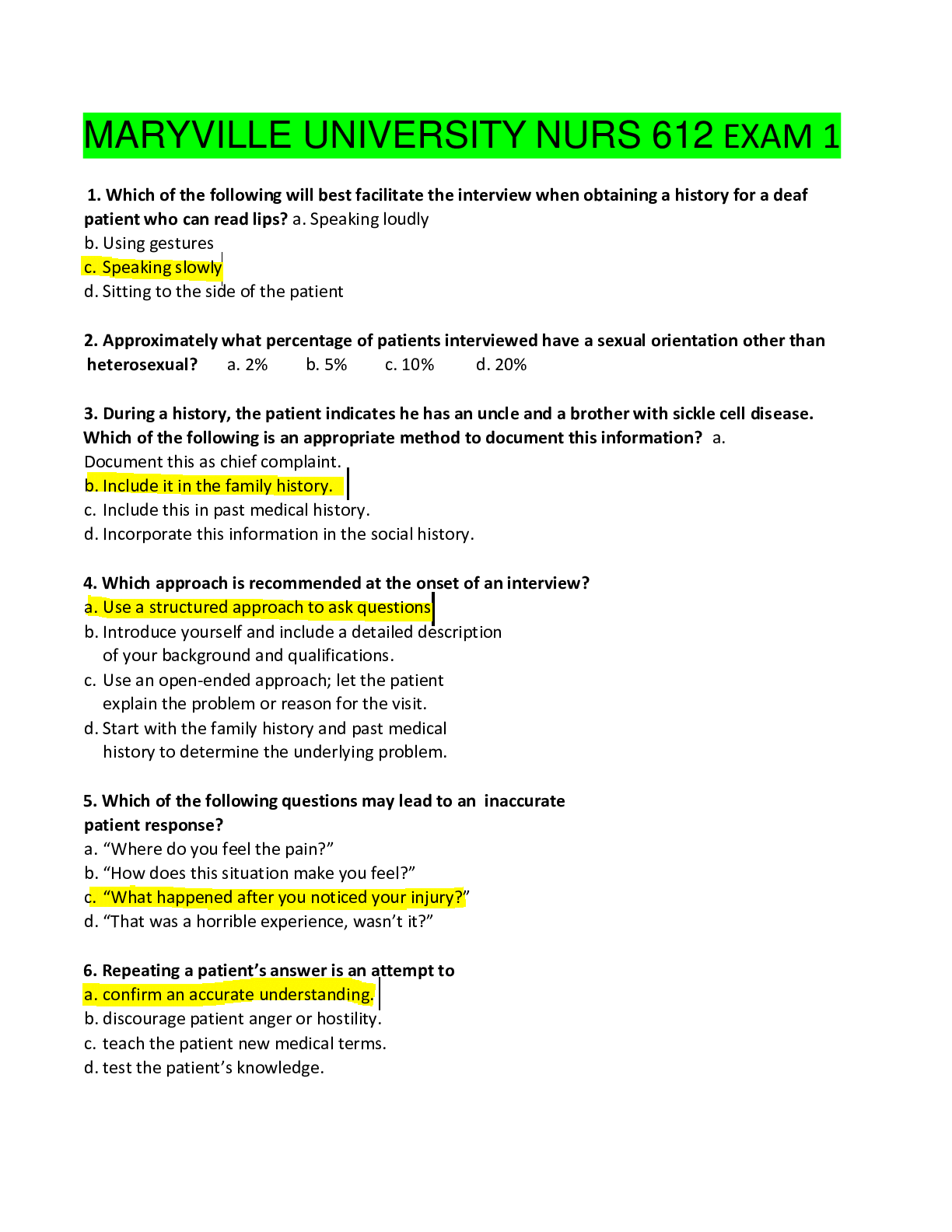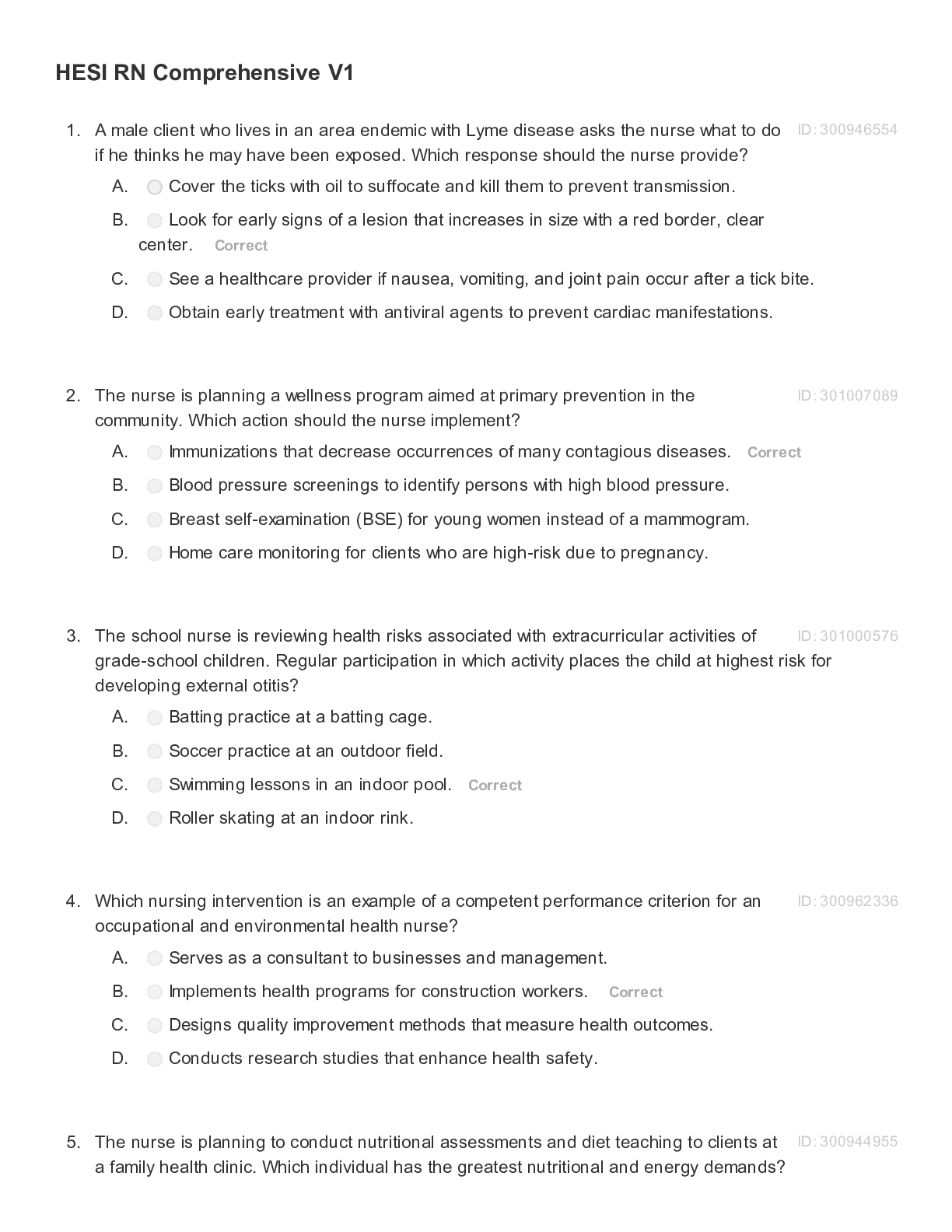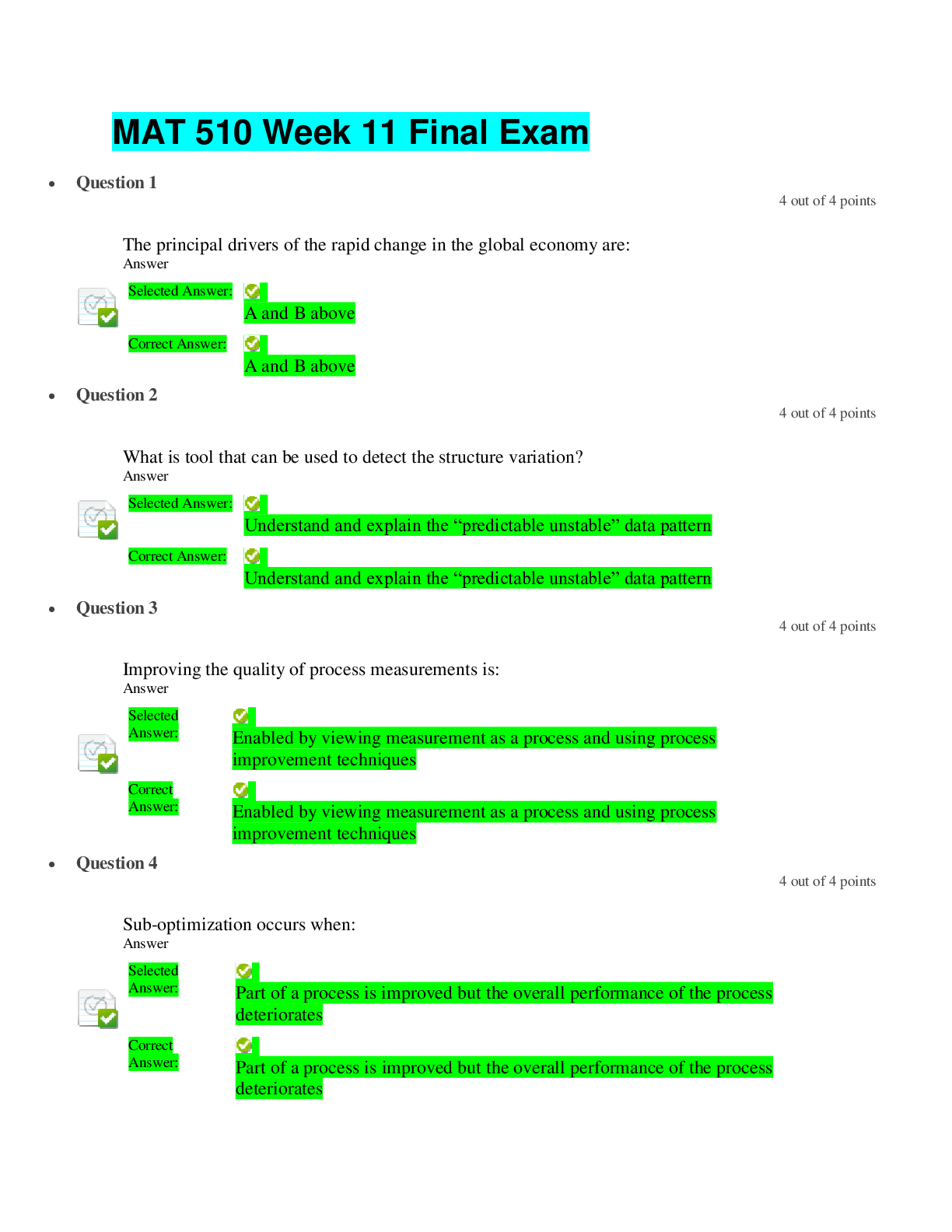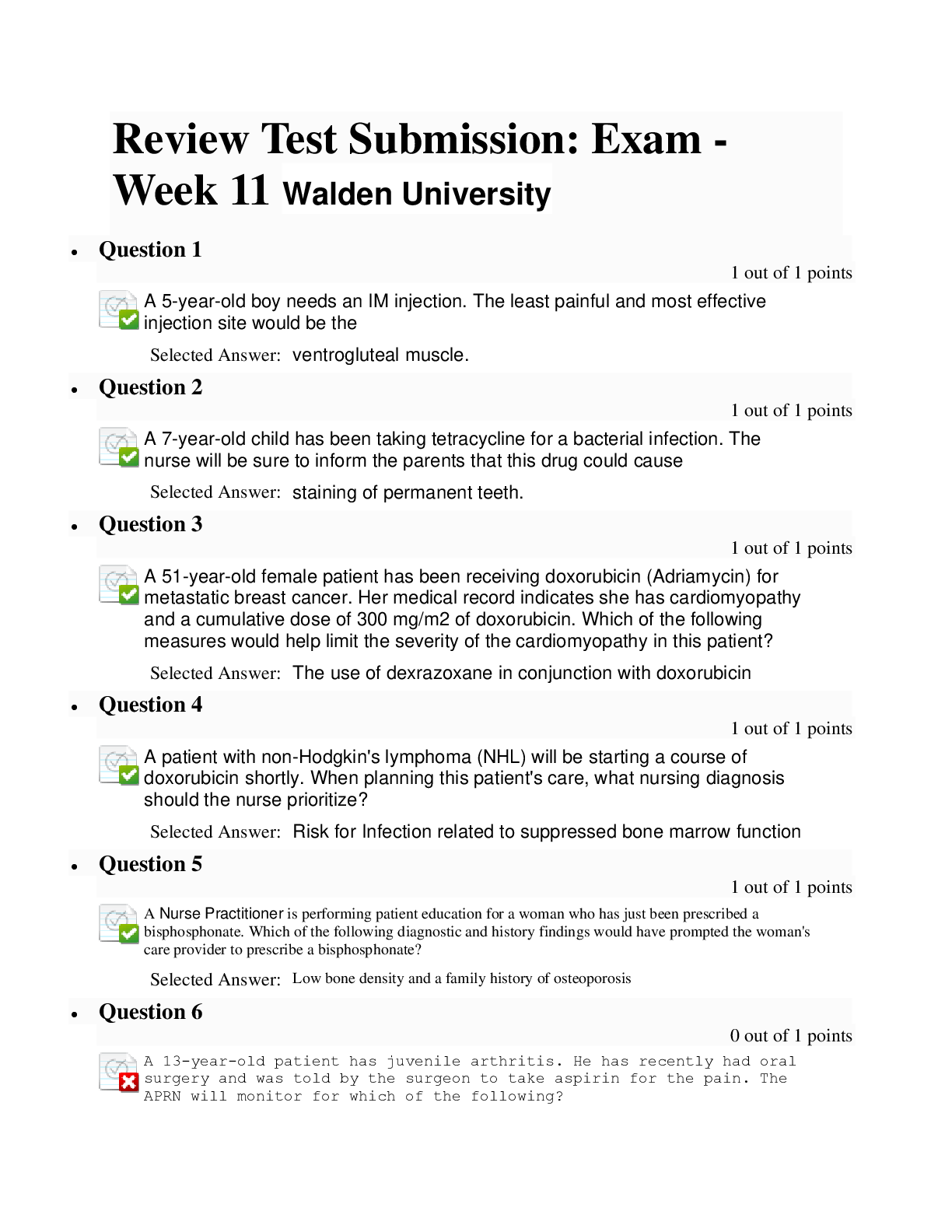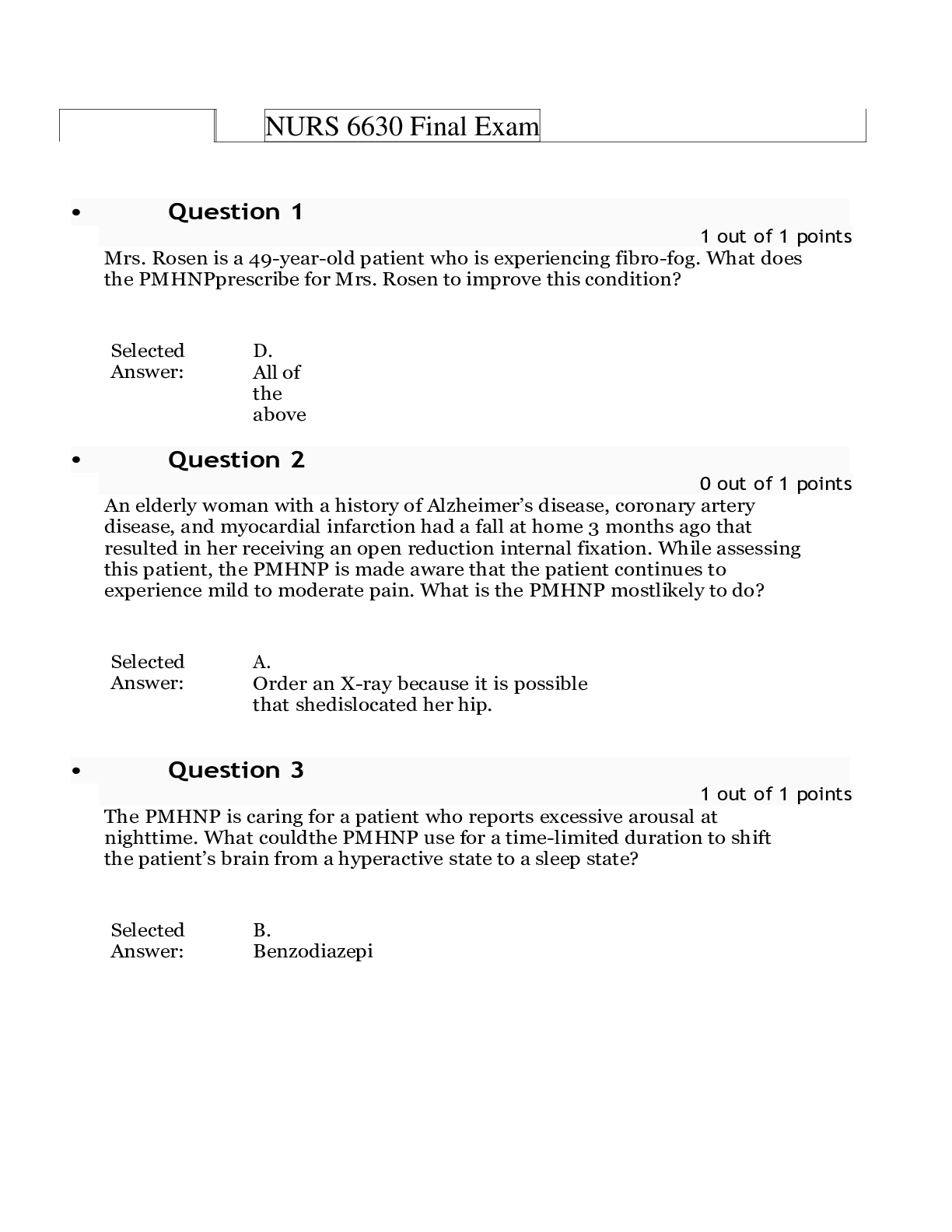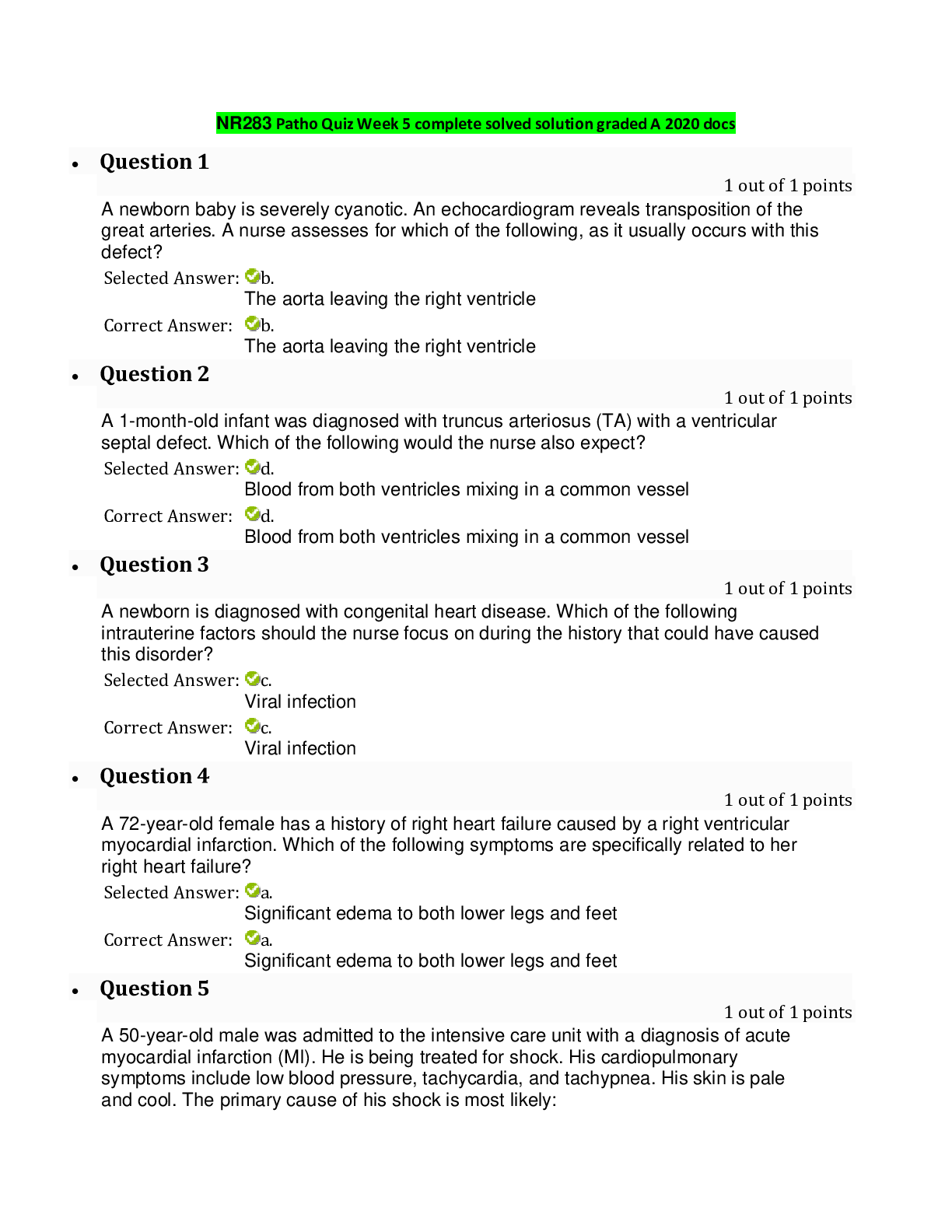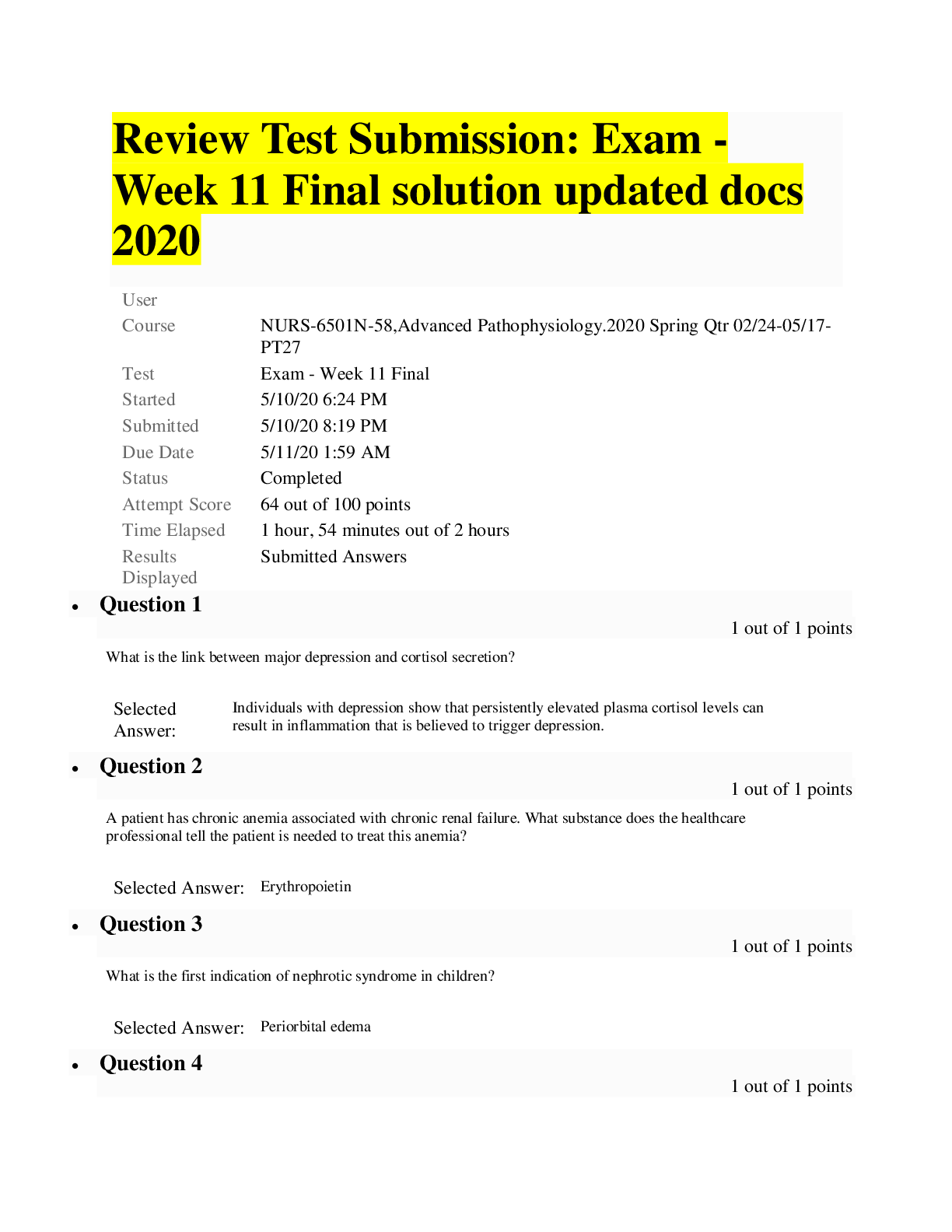Finance > QUESTIONS & ANSWERS > FIN 534- WEEK 11 FINAL EXAM WITH COMPLETE SOLUTION GRADED A (All)
FIN 534- WEEK 11 FINAL EXAM WITH COMPLETE SOLUTION GRADED A
Document Content and Description Below
FIN 534- WEEK 11 FINAL EXAM WITH COMPLETE SOLUTION GRADED A • Question 1 4 out of 4 points Braddock Construction Co.'s stock is trading at $20 a share. Call options that expire in three mon... ths with a strike price of $20 sell for $1.50. Which of the following will occur if the stock price increases 10%, to $22 a share? • Question 2 4 out of 4 points Which of the following statements is CORRECT? Response Feedback: Rationale: Answer c is correct. See Figure 8−1 and the related discussion. • Question 3 4 out of 4 points An analyst wants to use the Black-Scholes model to value call options on the stock of Heath Corporation based on the following data: ∙ The price of the stock is $40. ∙ The strike price of the option is $40. ∙ The option matures in 3 months (t = 0.25). ∙ The standard deviation of the stock's returns is 0.40, and the variance is 0.16. ∙ The risk-free rate is 6%. Given this information, the analyst then calculated the following necessary components of the Black-Scholes model: ∙ d1 = 0.175 ∙ d2 = −0.025 ∙ N(d1) = 0.56946 ∙ N(d2) = 0.49003 N(d1) and N(d2) represent areas under a standard normal distribution function. Using the Black-Scholes model, what is the value of the call option? • Question 4 4 out of 4 points You are a finance intern at Chambers and Sons and they have asked you to help estimate the company's cost of common equity. You obtained the following data: D1 = $1.25; P0 = $27.50; gL = 5.00% (constant); and F = 6.00%. What is the cost of equity raised by selling new common stock? • Question 5 4 out of 4 points The president and CFO of Spellman Transportation are having a disagreement about whether to use market value or book value weights in calculating the WACC. Spellman's balance sheet shows a total of noncallable $45 million long-term debt with a coupon rate of 7.00% and a yield to maturity of 6.00%. This debt currently has a market value of $50 million. The company has 10 million shares of common stock, and the book value of the common equity (common stock plus retained earnings) is $65 million. The current stock price is $22.50 per share; stockholders' required return, rs, is 14.00%; and the firm's tax rate is 40%. The CFO thinks the WACC should be based on market value weights, but the president thinks book weights are more appropriate. What is the difference between these two WACCs? • Question 6 4 out of 4 points You have been hired as a consultant by Feludi Inc.'s CFO, who wants you to help her estimate the cost of capital. You have been provided with the following data: rRF = 4.10%; RPM = 5.25%; and b = 1.30. Based on the CAPM approach, what is the cost of common from reinvested earnings? • Question 7 4 out of 4 points Suzanne's Cleaners is considering a project that has the following cash flow data. What is the project's payback? Year 0 1 2 3 4 5 Cash flows −$1,100 $300 $310 $320 $330 $340 • Question 8 4 out of 4 points Markman & Sons is considering Projects S and L. These projects are mutually exclusive, equally risky, and not repeatable and their cash flows are shown below. If the decision is made by choosing the project with the higher IRR, how much value will be forgone? Note that under certain conditions choosing projects on the basis of the IRR will not cause any value to be lost because the project with the higher IRR will also have the higher NPV, i.e., no conflict will exist. r: 10.00% Year 0 1 2 3 4 CFS −$1,025 $650 $450 $250 $50 CFL −$1,025 $100 $300 $500 $700 • Question 9 4 out of 4 points Hart Corp. is considering a project that has the following cash flow data. What is the project's IRR? Note that a project's IRR can be less than the cost of capital or negative, in both cases it will be rejected. Year 0 1 2 3 Cash flows −$1,000 $425 $425 $425 • Question 10 4 out of 4 points Spot-Free Car Wash is considering a new project whose data are shown below. The equipment to be used has a 3-year tax life, would be depreciated on a straight-line basis over the project's 3-year life, and would have a zero salvage value after Year 3. No new working capital would be required. Revenues and other operating costs will be constant over the project's life, and this is just one of the firm's many projects, so any losses on it can be used to offset profits in other units. If the number of cars washed declined by 40% from the expected level, by how much would the project's NPV decline? (Hint: Note that cash flows are constant at the Year 1 level, whatever that level is.) Project cost of capital (r) 10.0% Net investment cost (depreciable basis) $60,000 Number of cars washed 2,800 Average price per car $25.00 Fixed op. cost (excl. deprec.) $10,000 Variable op. cost/unit (i.e., VC per car washed) $5.375 Annual depreciation $20,000 Tax rate 35.0% • Question 11 4 out of 4 points McPherson Company must purchase a new milling machine. The purchase price is $50,000, including installation. The machine has a tax life of 5 years, and it can be depreciated according to the following rates. The firm expects to operate the machine for 4 years and then to sell it for $12,500. If the marginal tax rate is 40%, what will the after-tax salvage value be when the machine is sold at the end of Year 4? Year Depreciation Rate 1 0.20 2 0.32 3 0.19 4 0.12 5 0.11 6 0.06 • Question 12 4 out of 4 points Which of the following procedures does the text say is used most frequently by businesses when they do capital budgeting analyses? • Question 13 4 out of 4 points Which of the following statements is CORRECT? • Question 14 4 out of 4 points Spontaneous funds are generally defined as follows: • Question 15 4 out of 4 points F. Marston, Inc. has developed a forecasting model to estimate its AFN for the upcoming year. All else being equal, which of the following factors is most likely to lead to an increase of the additional funds needed (AFN)? • Question 16 4 out of 4 points Which of the following is NOT normally regarded as being a barrier to hostile takeovers? • Question 17 4 out of 4 points Silvana Inc. projects the following data for the coming year. If the firm follows the residual dividend policy and also maintains its target capital structure, what will its payout ratio be? EBIT $2,000,000 Capital budget $850,000 Interest rate 10% % Debt 40% Debt outstanding $5,000,000 % Equity 60% Shares outstanding $5,000,000 Tax rate 40% • Question 18 4 out of 4 points The following data apply to Elizabeth's Electrical Equipment: Value of operations $20,000 Short-term investments $1,000 Debt $6,000 Number of shares 300 The company plans on distributing $50 million by repurchasing stock. What will the intrinsic per share stock price be immediately after the repurchase? • Question 19 4 out of 4 points Warren Supply Inc. is evaluating its capital budget. The company finances with debt and common equity, but because of market conditions, wants to avoid issuing any new common stock during the coming year. It is forecasting an EPS of $3.00 for the coming year on its 500,000 outstanding shares of stock. Its capital budget is forecasted at $800,000, and it is committed to maintaining a $2.00 dividend per share. Given these constraints, what percentage of the capital budget must be financed with debt? • Question 20 4 out of 4 points Serendipity Inc. is re-evaluating its debt level. Its current capital structure consists of 80% debt and 20% common equity, its beta is 1.60, and its tax rate is 35%. However, the CFO thinks the company has too much debt, and he is considering moving to a capital structure with 40% debt and 60% equity. The risk-free rate is 5.0% and the market risk premium is 6.0%. By how much would the capital structure shift change the firm's cost of equity? • Question 21 4 out of 4 points Firms HD and LD are identical except for their level of debt and the interest rates they pay on debt⎯HD has more debt and pays a higher interest rate on that debt. Based on the data given below, what is the difference between the two firms' ROEs? Applicable to Both Firms Firm HD's Data Firm LD's Data Assets $200 Debt ratio 50% Debt ratio 30% EBIT $40 Interest rate 12% Interest rate 10% Tax rate 35% • Question 22 4 out of 4 points Which of the following events is likely to encourage a company to raise its target debt ratio, other things held constant? • Question 23 4 out of 4 points Which of these items will not generally be affected by an increase in the debt ratio? • Question 24 4 out of 4 points Other things held constant, which of the following would tend to reduce the cash conversion cycle? • Question 25 4 out of 4 points Fairweather Corporation purchases merchandise on terms of 2/15, net 40, and its gross purchases (i.e., purchases before taking off the discount) are $800,000 per year. What is the maximum dollar amount of costly trade credit the firm could get, assuming it abides by the supplier's credit terms? (Assume a 365-day year.) • Question 26 4 out of 4 points Andrews Corporation buys on terms of 2/8, net 45 days, it does not take discounts, and it actually pays after 58 days. What is the effective annual percentage cost of its non-free trade credit? (Use a 365-day year.) • Question 27 0 out of 4 points Which of the following statements is NOT CORRECT? • Question 28 4 out of 4 points Suppose Yates Inc., a U.S. exporter, sold a consignment of antique American muscle-cars to a Japanese customer at a price of 143.5 million yen, when the exchange rate was 140 yen per dollar. In order to close the sale, Yates agreed to make the bill payable in yen, thus agreeing to take some exchange rate risk for the transaction. The terms were net 6 months. If the yen fell against the dollar such that one dollar would buy 154.4 yen when the invoice was paid, what dollar amount would Yates actually receive after it exchanged yen for U.S. dollars? • Question 29 4 out of 4 points Suppose Stackpool Inc. had inventory in Britain valued at 240,000 pounds one year ago. The exchange rate for dollars to pounds was 1£ = 2 U.S. dollars. This year the exchange rate is 1£ = 1.82 U.S. dollars. The inventory in Britain is still valued at 240,000 pounds. What is the gain or loss in inventory value in U.S. dollars as a result of the change in exchange rates? • Question 30 4 out of 4 points Suppose one U.S. dollar can purchase 144 yen today in the foreign exchange market. If the yen depreciates by 8.0% tomorrow, how many yen could one U.S. dollar buy tomorrow? [Show More]
Last updated: 2 years ago
Preview 1 out of 16 pages

Buy this document to get the full access instantly
Instant Download Access after purchase
Buy NowInstant download
We Accept:

Reviews( 0 )
$9.00
Can't find what you want? Try our AI powered Search
Document information
Connected school, study & course
About the document
Uploaded On
Dec 29, 2020
Number of pages
16
Written in
Additional information
This document has been written for:
Uploaded
Dec 29, 2020
Downloads
0
Views
147





